Mechanical Properties of Parallel TDG Bamboo Laminated Columns with Tough and Grove Joints
Abstract
:1. Introduction
2. Materials and Methods
2.1. Code and Specimens
2.2. Experimental Tests
3. Test Results and Discussion
3.1. Failure Mode
3.1.1. At the Tongue and Groove
3.1.2. Splitting Mode
3.1.3. Splitting + Buckling Mode
3.1.4. Type at Location TB
- The failure of TDGLC + TG specimens with top and bottom joining (TB) had the least compressive strength due to the column being cut to connect numerous parts, which will cause a reduction in the strength of the column.
- The failure of TDGLC + TG specimens joined at the bottom (B) had the least compressive strength due to the column joint being closest to the compression force and the TDGLC + TC losing strength quickly.
3.2. Ultimate Load Capacity and Slenderness Ratio
3.3. The Relationship between Stress and Strain
3.3.1. TDGLC + TG at T and B
- Test results (stress, strain) are in descending order: B1 (5.96, 0.0029), B2 (4.73, 0.0015), and B3 (3.84, 0.0010) are the points.
- Test results (stress, strain) are in descending order: TB1 (6.33, 0.0029), TB2 (5.37, 0.0015), and TB3 (4.11, 0.0010) are the points.
3.3.2. TDGLC + TG at T and M
- 3.
- Test results (stress, strain) are in descending order: T1 (209.29, 0.0029), T2 (166.04, 0.0015), and T3 (3.84, 0.0010) are the points.
- 4.
- Test results (stress, strain) are in descending order: M1 (186.84, 0.0029), M2 (146.45, 0. 0015), and M3 (118.94, 0.0010) are the points.
3.4. Strain–Slenderness Ratio Analysis
- TDGLC + TG with the top connection type 4L01 T-4L03 T can withstand maximum loads ranging from 139.23 to 215.57 kN with a slenderness ratio of 34.6–103.92.
- TDGLC + TG with the middle connection type 4L01 M-4L03 M can bear a maximum load of between 125.5 and 190.19 at a slenderness ratio of 34.6 to 100.38.
- TDGLC + TG with the top-bottom connection type 4L01 TB and 4L03 TB can withstand high loads between 42.35 and 65.20 kN at a slenderness ratio of 42.35 to 65.20.
- TDGLC + TG type 4L01 B-4L03 B can withstand loads ranging from 39.58 to 61.36 kN while maintaining a slenderness ratio of 34.64 to 102.92.
| Specimens | Length (mm) | Strain | Slenderness Ratio | Ultimate Capacity (kN) |
|---|---|---|---|---|
| 4L03 B | 3000 | 0.0010 | 103.92 | 39.58 |
| 4L02 B | 2000 | 0.0015 | 69.28 | 48.69 |
| 4L01 B | 1000 | 0.0029 | 34.64 | 61.36 |
| 4L03 TB | 3000 | 0.0010 | 103.92 | 42.35 |
| 4L02 TB | 2000 | 0.0015 | 69.28 | 55.33 |
| 4L01TB | 1000 | 0.0029 | 34.64 | 65.20 |
| 4L03 M | 3000 | 0.0010 | 103.92 | 122.51 |
| 4L02 M | 2000 | 0.0015 | 69.28 | 150.44 |
| 4L01 M | 1000 | 0.0029 | 34.64 | 190.19 |
| 4L03 T | 3000 | 0.0010 | 103.92 | 139.23 |
| 4L02 T | 2000 | 0.0015 | 69.28 | 171.03 |
| 4L01 T | 1000 | 0.0029 | 34.64 | 215.57 |
4. Discussion
4.1. Load vs. Strain Comparison
4.2. Slenderness vs. Load
5. Summary and Conclusions
5.1. Load vs. Slenderness Ratio
5.2. Stress vs. Strain
Author Contributions
Funding
Institutional Review Board Statement
Informed Consent Statement
Data Availability Statement
Conflicts of Interest
Abbreviations
| TDG | Thai Dendrocalamus Giganteus |
| TDGLC + TG | Thai Dendrocalamus Giganteus bamboo laminated column with Tongue and Groove joint |
References
- Amada, S.; Ichikawa, Y.; Munekata, T.; Nagase, Y.; Shimizu, H. Fiber texture and mechanical graded structure of bamboo. J. Compos. Part B Eng. 1997, 28, 13–20. [Google Scholar] [CrossRef]
- Díaz, G. Influencia de la Densidad Aparente de Fibras sobre la Resistencia a Esfuerzos de Compresión, Tensión y Flexión de la Guadua (Influence of the Apparent Density of Fibers on the Compressive Strength, Tension and Bending of Guadua). Master’s Thesis, Universidad Industrial de Santander, Bucaramanga, Colombia, 2011. [Google Scholar]
- Yeh, M.-C.; Lin, Y.-L. Finger joint performance of structural laminated bamboo member. J. Wood Sci. 2011, 58, 120–127. [Google Scholar] [CrossRef]
- Li, H.; Zhang, Q.; Huang, D.; Deeks, A.J. Compressive performance of laminated bamboo. J. Compos. Part B Eng. 2013, 54, 319–328. [Google Scholar] [CrossRef]
- López, L.F. Estudio Exploratorio del Potencial Estructural de Laminados de Guadua (Exploratory Study of the Glued Laminated Bamboo Guadua Angustifolia as a Structural Material. Master’s Thesis, Universidad de Los Andes, Bogotá, Colombia, 2008. [Google Scholar]
- De Flander, K. The Role of Bamboo in Global Modernity: From Traditional to Innovative Construction Material. Master’s Thesis, Wageningen University, Wageningen, The Netherlands, 2005. [Google Scholar]
- Karthik, S.; Rao, P.R.M.; Awoyera, P. Strength properties of bamboo and steel reinforced concrete containing manufactured sand and mineral admixtures. J. King Saud Univ.-Eng. Sci. 2017, 29, 400–406. [Google Scholar]
- Sharma, B.; Gatóo, A.; Ramage, M.H. Effect of processing methods on the mechanical properties of engineered bamboo. Constr. Build. Mater. 2015, 83, 95–101. [Google Scholar] [CrossRef]
- Li, X. Research on Mechanics and Failure Properties of Moso Bamboo. Master’s Thesis, Chinese Academy of Forestry, Beijing, China, 2009. [Google Scholar]
- Tang, G.; Yin, L.; Li, Z.; Li, Y.; You, L. Structural behaviors of bolted connections using laminated bamboo and steel plates. Structures 2019, 20, 324–339. [Google Scholar] [CrossRef]
- Mali, P.R.; Datta, D. Experimental evaluation of bamboo reinforced concrete beams. J. Build. Eng. 2020, 28, 101071. [Google Scholar] [CrossRef]
- Sharma, B.; van der Vegte, A. Engineered bamboo for structural applications. In Nonconventional and Vernacular Construction Materials; Elsevier: Amsterdam, The Netherlands, 2020; pp. 597–623. [Google Scholar]
- Thammapornram, C. The Innovation of Dendrocalamus Giganteus Bamboo Beam. Ph.D. Thesis, Faculty of Engineering Law and Inspection, Ramkhamhaeng University, Bangkok, Thailand, 2018. [Google Scholar]
- Thamapornram, C.; Kongsong; Buranakarn, V. Thai Dendrocalamus Giganteus. J. Science, Technology, and Architecture, ESTCON Thailand, 2018; pp.60–70. Available online: https://estcon.utp.edu.my/ (accessed on 2 September 2022).
- Thammapornram, C.; Kongsong, W.; Buranakarn, V. Effecting factors of mechanical properties of thai dendrocalamus giganteus bamboo. Int. J. Civ. Eng. Technol. 2018, 9, 1457–1467. [Google Scholar]
- Songkarn, K. The Innovation of Dendrocalamus Giganteus Bamboo Column. Ph.D. Thesis, Faculty of Engineering Law and Inspection, Ramkhamhaeng University, Bangkok, Thailand, 2019. [Google Scholar]
- Muhammad, F.; Haris, M.; Khan, W.; Zaman, S. Bamboo as a construction material: Prospects and challenges. Adv. Sci. Technol. Res. J. 2022, 16, 165–175. [Google Scholar]
- Kumar, G.; Ashish, D.K. Review on feasibility of bamboo in modern construction. J. Civ. Eng. 2015, 2, 66–70. [Google Scholar]
- Habibi, S. Design concepts for the integration of bamboo in contemporary vernacular architecture. Archit. Eng. Des. Manag. 2019, 15, 475–489. [Google Scholar]
- Liese, W. Research on bamboo. Wood Science and Figure 7. Load-displacement relations in split tensile tests for FRBC and PCC. Adv. Sci. Technol. Res. J. 2022, 16, 165–175. [Google Scholar]
- Sayan, K. The Innovation of Thai Dendrocalamus Giganteus Bamboo Joints According to Building Control Act and Safety Standard. Ph.D. Thesis, Faculty of Engineering Law and Inspection, Ramkhamhaeng University, Bangkok, Thailand, 2019. [Google Scholar]
- Kongsricharoen, S.; Kongsong, W.; Tuprakay, S.; Tuprakay, S.; Thammapornram, C. Analysis the shear strength of Thai Dendrocalamus Gigantues (TDG) lamented bamboo by the factor of glue and location of the strips. Int. J. Civ. Eng. Technol. 2019, 10, 253–262. [Google Scholar]
- Ashaari, Z.; Mamat, N. Traditional treatment of Malaysian bamboos: Resistance towards white rot fungus and durability in service. Pak. J. Biol. Sci. 2000, 3, 1453–1458. [Google Scholar]
- Kasim, J. Properties of Particleboard and Particle-filled Thermoplastic Composite from Bamboo (Gigantochloa Scortecchinii). Master’s Thesis, Universiti Putra Malaysia, Selangor, Malaysia, 1999. [Google Scholar]
- Parameswaran, N.; Liese, W. On the fine structure of bamboo fibres. Wood Sci. Technol. 1976, 10, 231–246. [Google Scholar] [CrossRef]
- Sharma, Y. Editor bamboos in the Asia Pacific Region. Bamboo research in Asia. In Proceedings of the Bamboo in the Asia Pacific Region Workshop, Singapore, 28–30 May 1980; IDRC: Ottawa, ON, Canada, 1980. [Google Scholar]
- Thammapornram, C. The Innovation of Dendrocalamus Giganteus Bamboo Column. Available online: https://megabamtech1212.com/bamboo-column/ (accessed on 10 October 2022).
- Rachata, P.; Waranon, K.; Chaleeporn, T. Analysis of physical properties Thai Dendrocalamus Gigantues (TDG) bamboo case study strips making. Int. J. Adv. Res. Eng. Technol. 2021, 11, 816–828. [Google Scholar]
- Krittapat, K.; Waranon, K.; Chaleeporn, T. Analysis of physical properties The Dendrocalamus Gigantues (TDG) bamboo case study the factor of differnt location Node and Internode. Int. J. Manag. 2022, 11, 308–318. [Google Scholar]
- Rachata, P.; Waranon, K.; Chaleeporn, T. Analysis of emission factor in Thailand for vechicle transportation that affects the carbon foorprint in production process of Thai Dendrocalamus Gigantues (TDG) laminated. Int. J. Adv. Res. Eng. Technol. 2021, 12, 816–828. [Google Scholar]
- ASTM D143-09; Standard Test Method for Small Clear Specimens of Timber. ASTM international: West Conshohocken, PA, USA, 2009.
- DPT 1221-51; Standards Test of Wood. The Bureau of Building Inspection and Control Department of Public Works and Town & Country Planning: Bangkok, Thailand, 2022.
- DPT 1225-51; Standards Test Method for Tensile Test of Wood. The Bureau of Building Inspection and Control Department of Public Works and Town & Country Planning: Bangkok, Thailand, 2022.
- DPT 1224-51; Standards Test for Bending Test of Wood. The Bureau of Building Inspection and Control Department of Public Works and Town & Country Planning: Bangkok, Thailand, 2022.
- DPT 1222-51; Standards Test for Compressive Strength of Wood. The Bureau of Building Inspection and Control Department of Public Works and Town & Country Planning: Bangkok, Thailand, 2022.
- Krittapat, K.; Waranon, K.; Chaleeporn, T. Analysis of thai Dendrocalamus Gigantues bamboo (TDG) strip method of production a different method. Int. J. Adv. Res. Eng. Technol. 2021, 12, 75–87. [Google Scholar]
- Zhang, J.P.; Wang, S.S.; Gong, S.; Zuo, Q.S.; Hu, H.Y. Thermo-mechnical coupling analysis of the orthropic structures by using element –free Galerkin method. Eng. Anal. Bounday Elem. 2019, 101, 198–213. [Google Scholar] [CrossRef]
- Kabir, H.; Aghdam, M.M. A generalized 2D Bezier based solution for stress analysis of notch epoxy resin plates reinforced with graphene nanoplatets. Thin-Walled Struct. 2021, 169, 108484. [Google Scholar] [CrossRef]
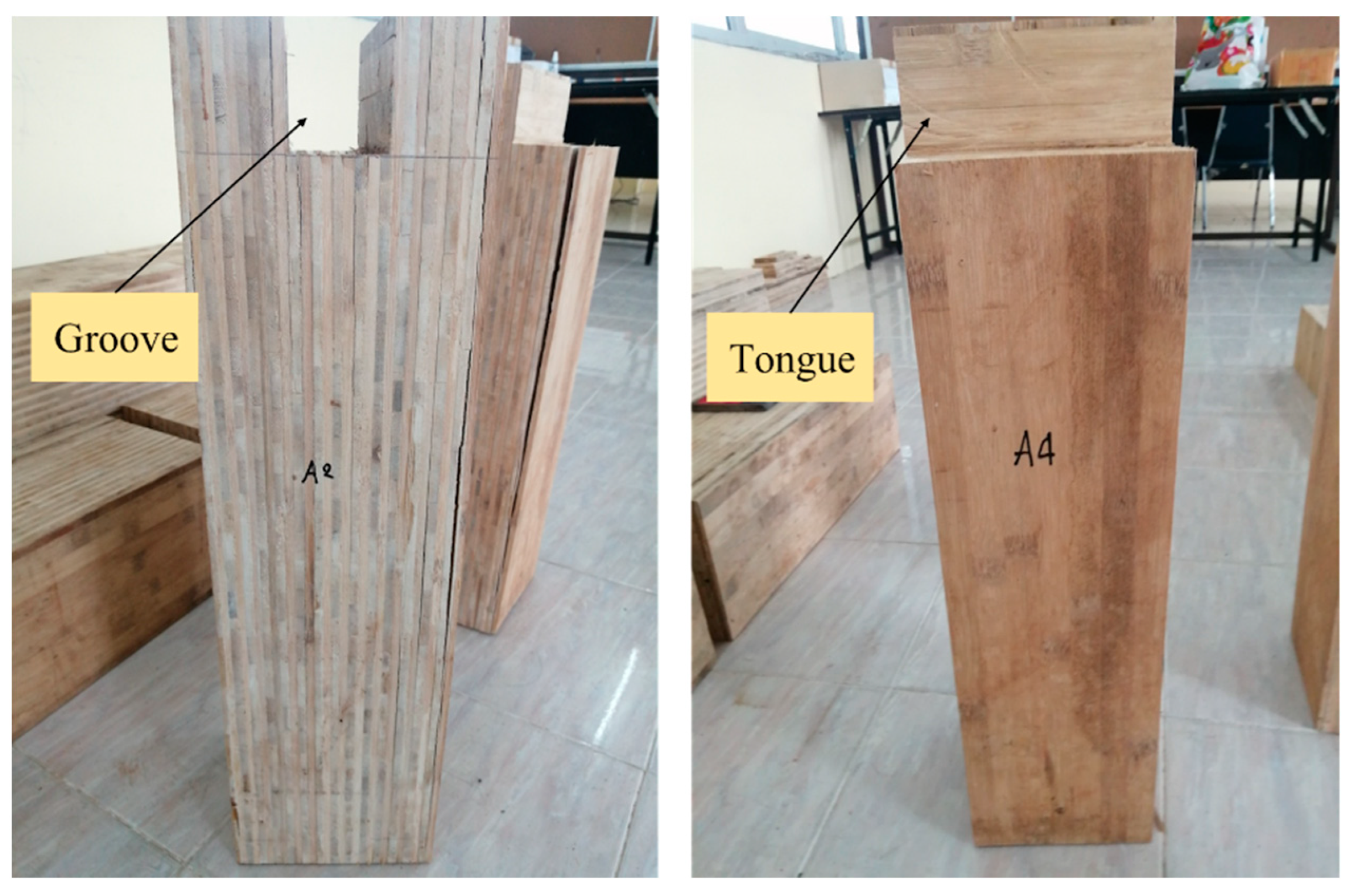
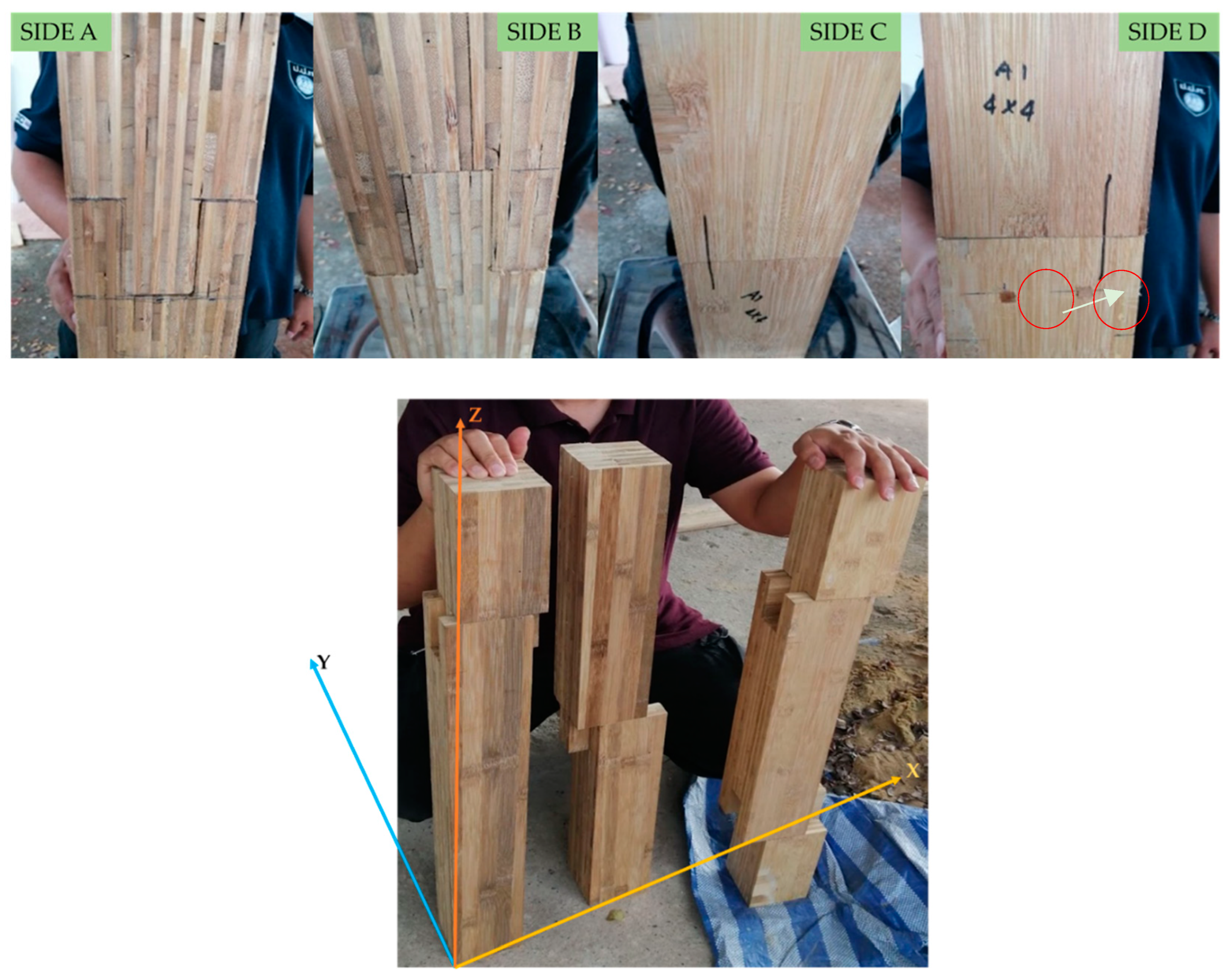

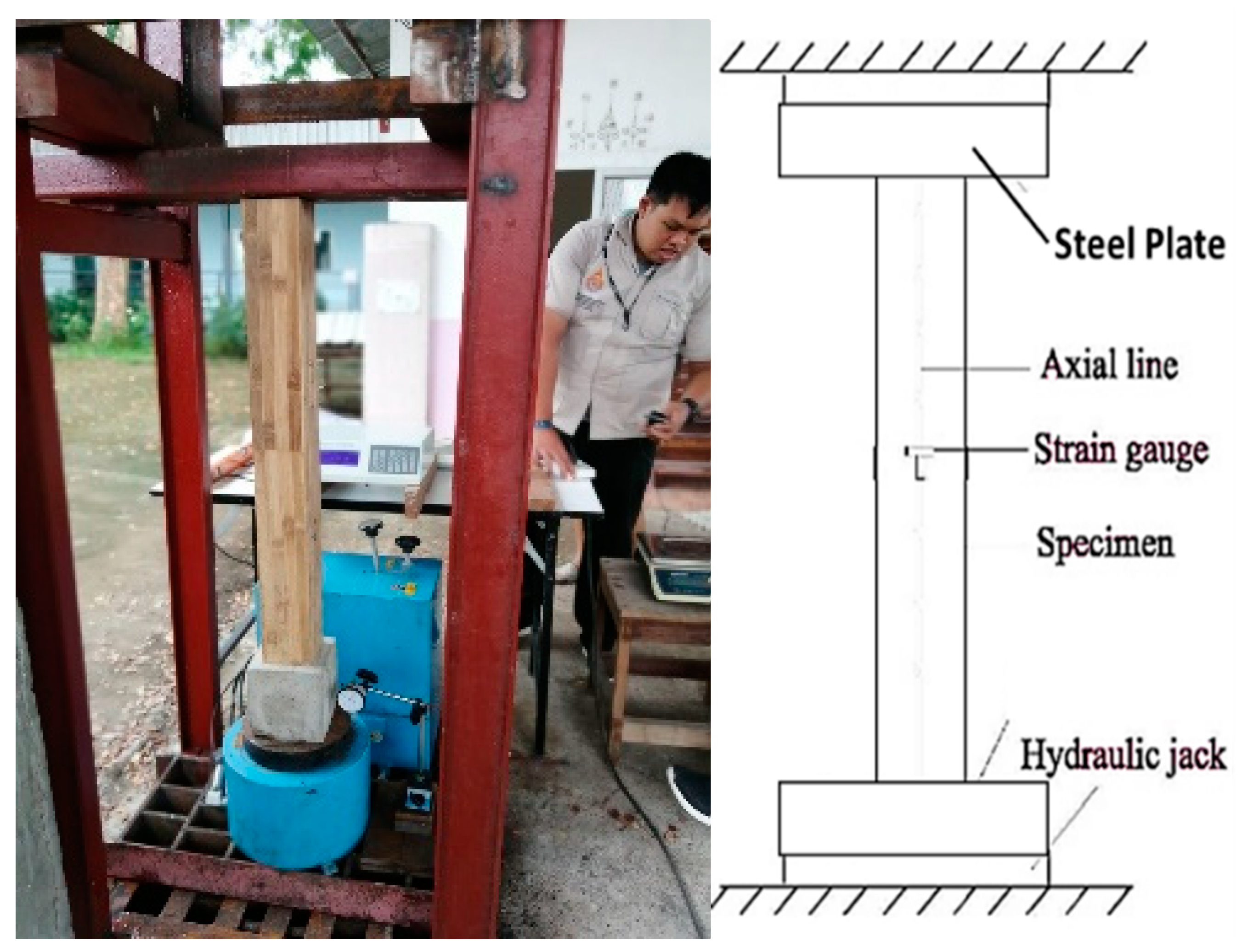
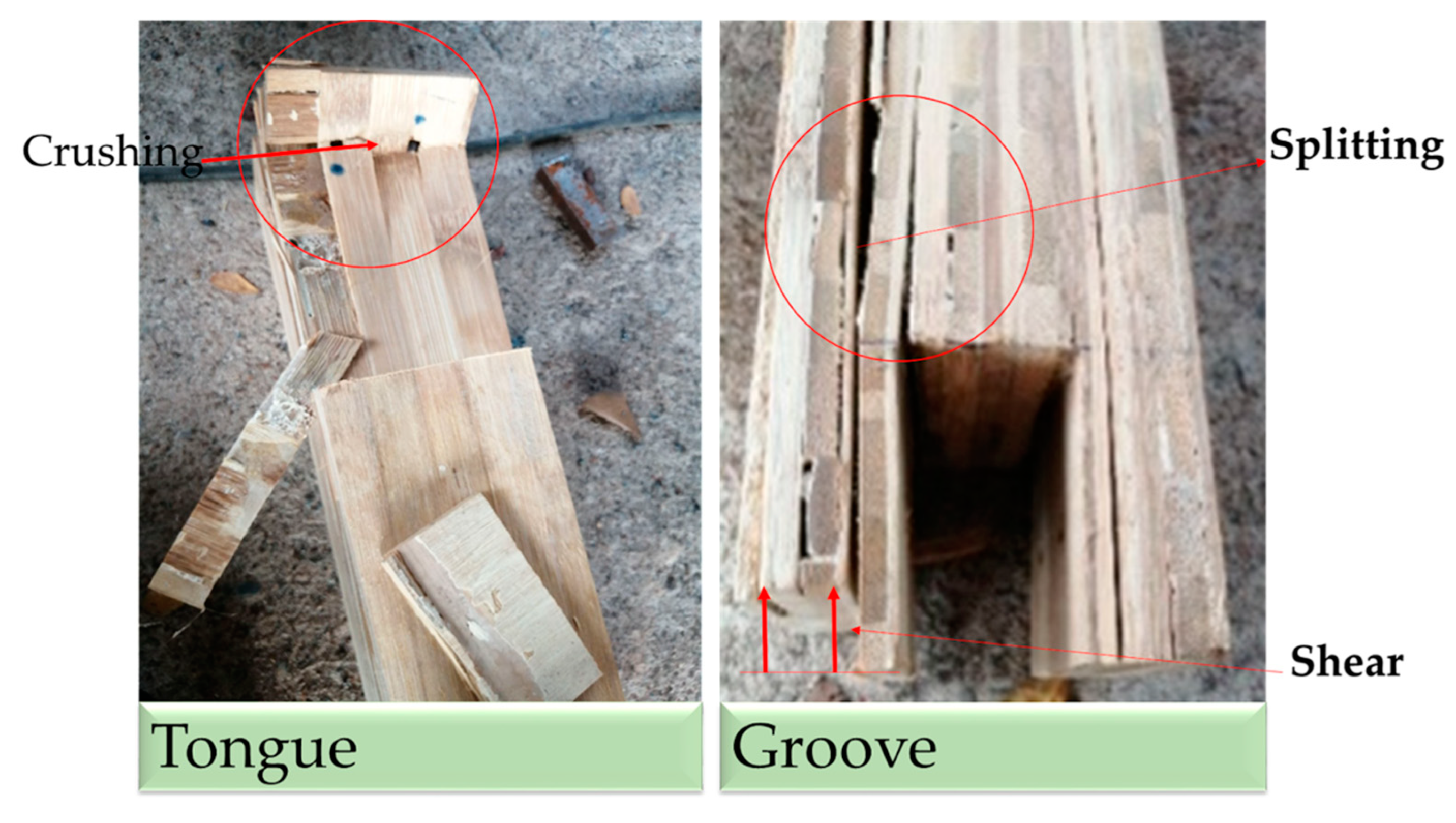
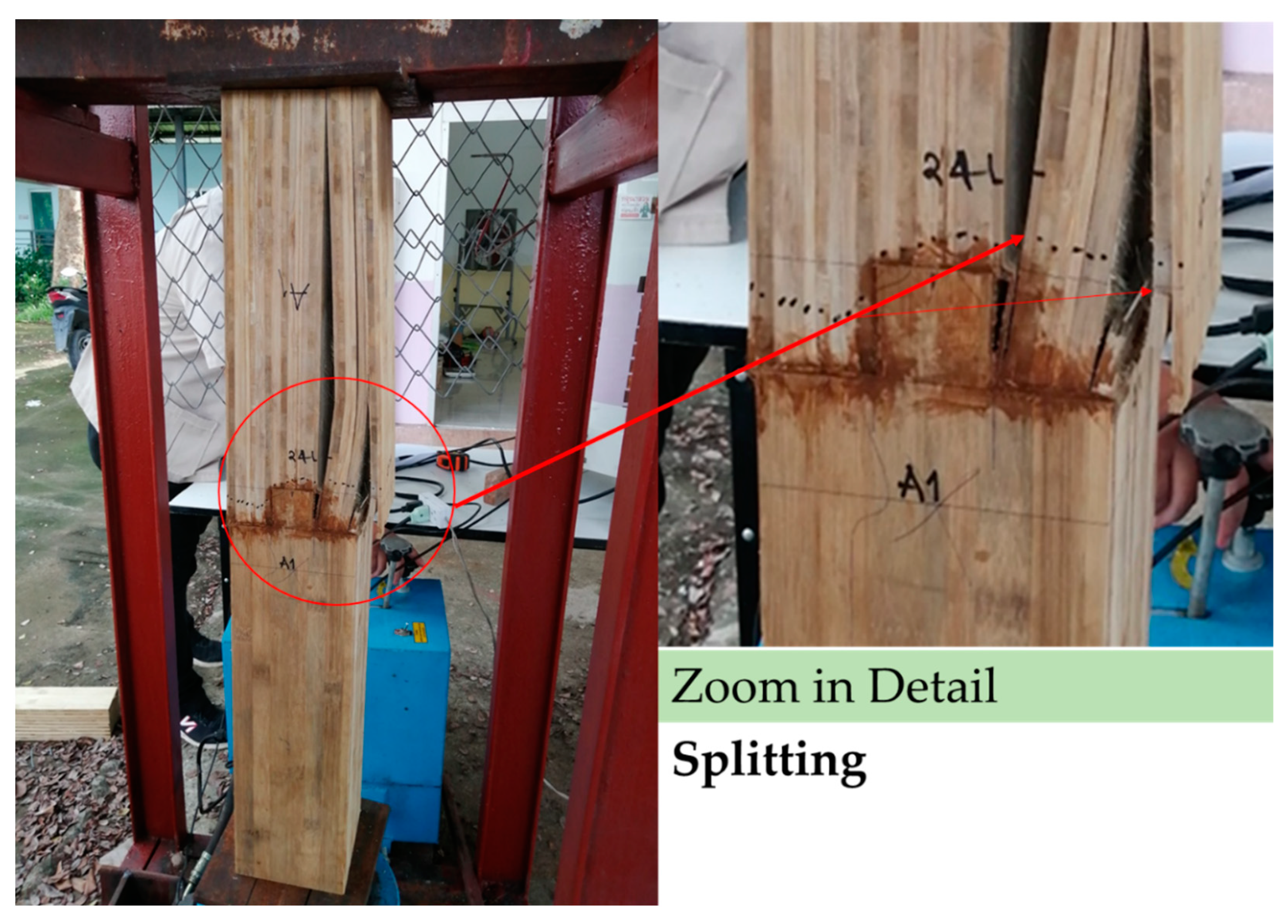
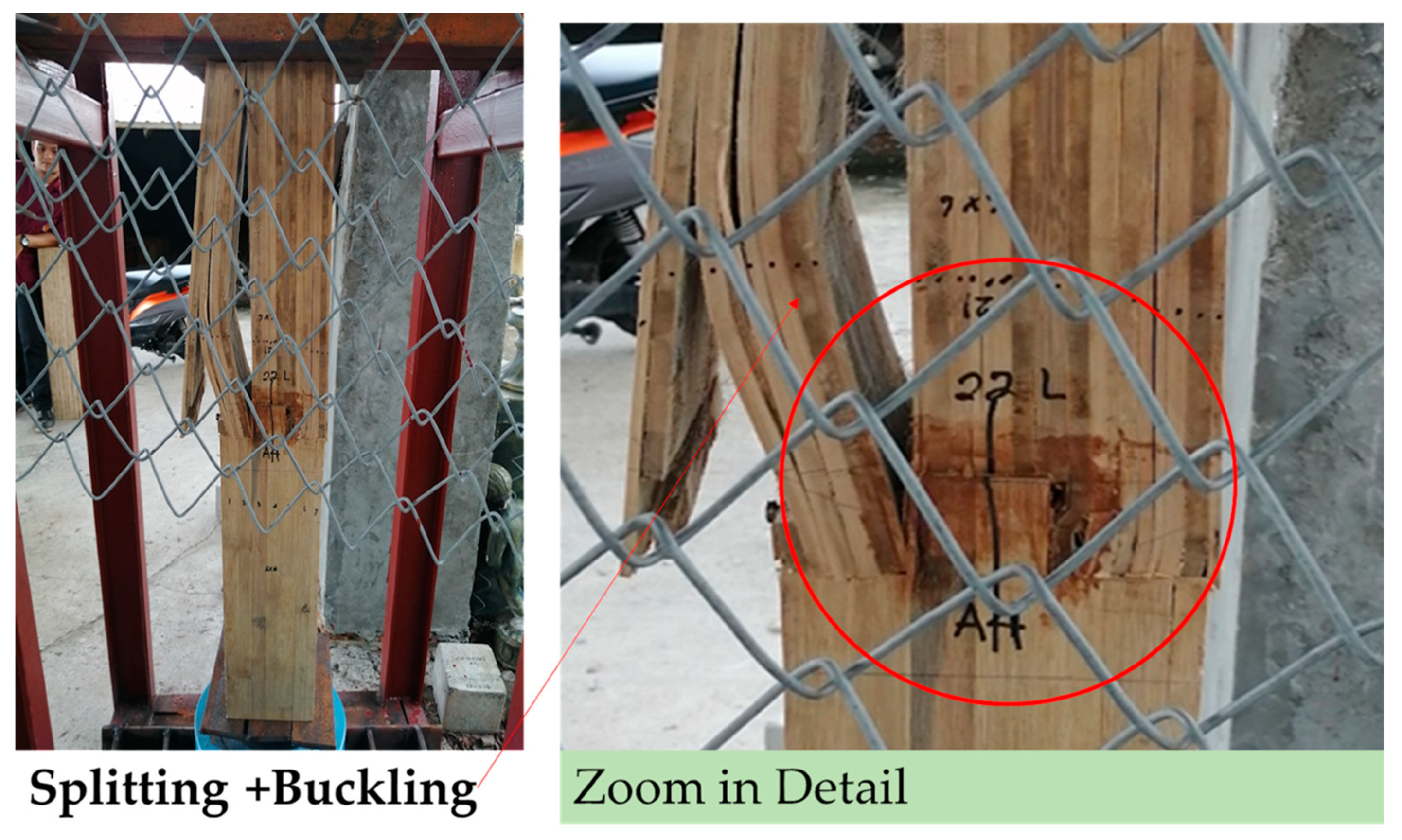
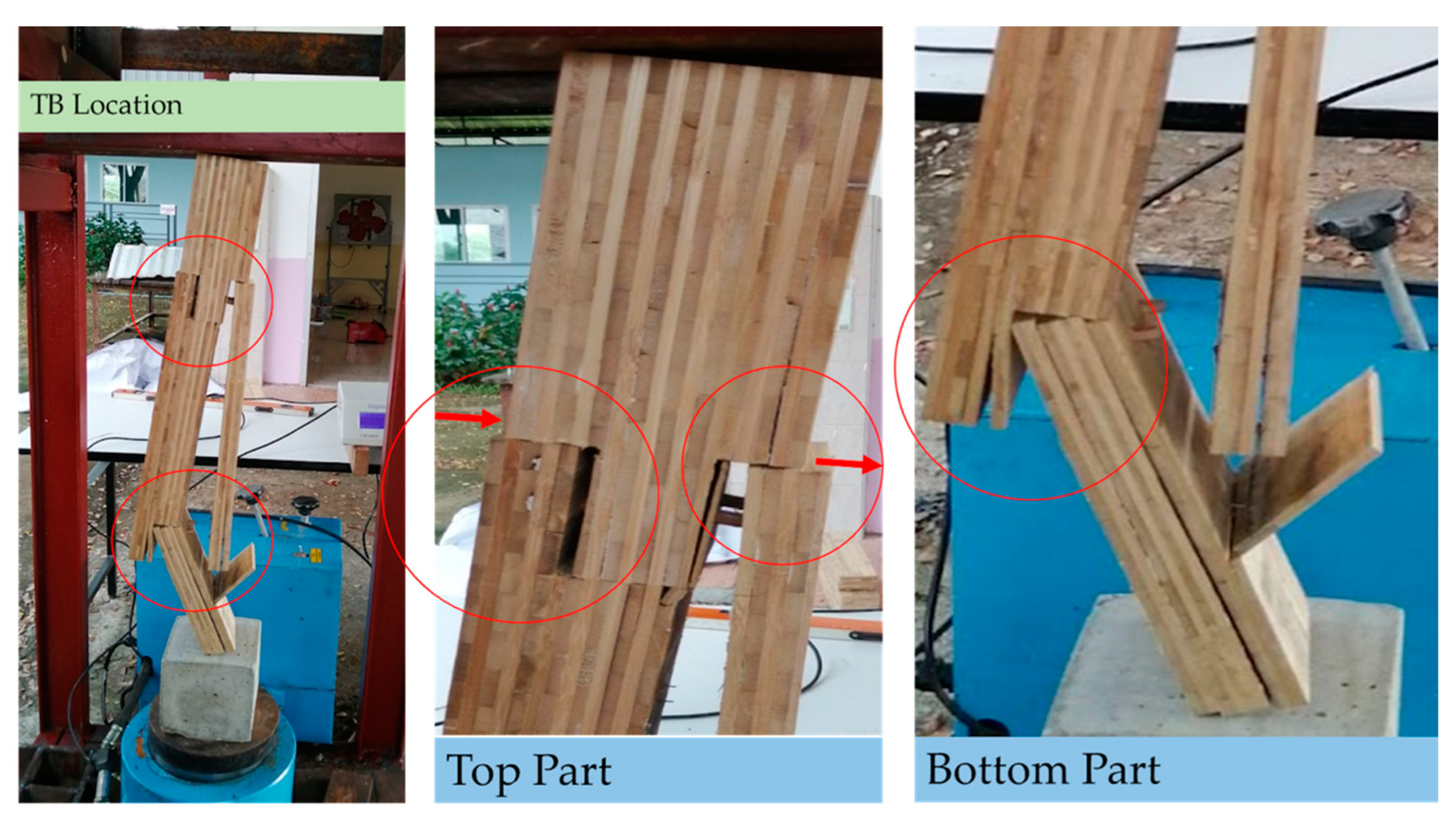
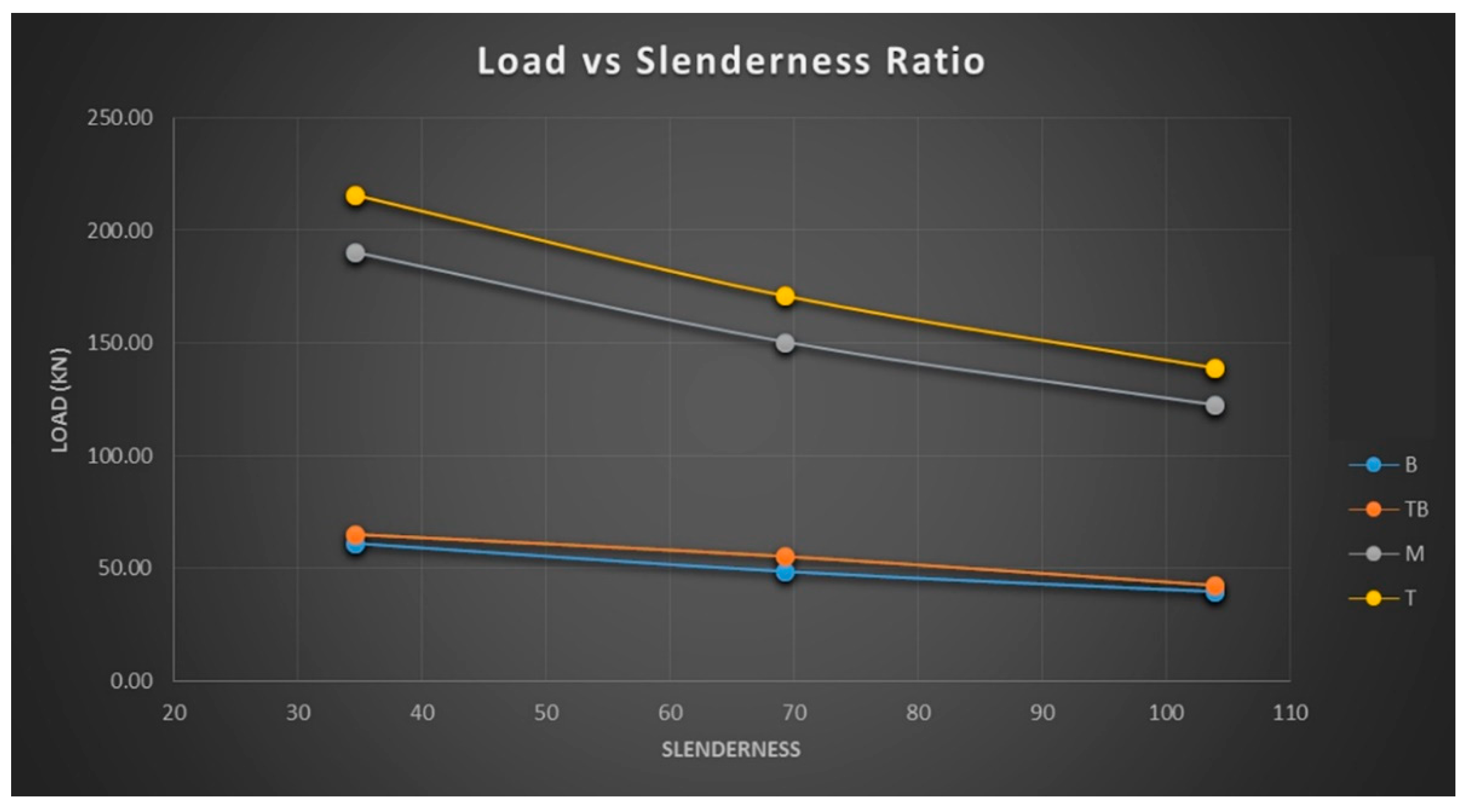
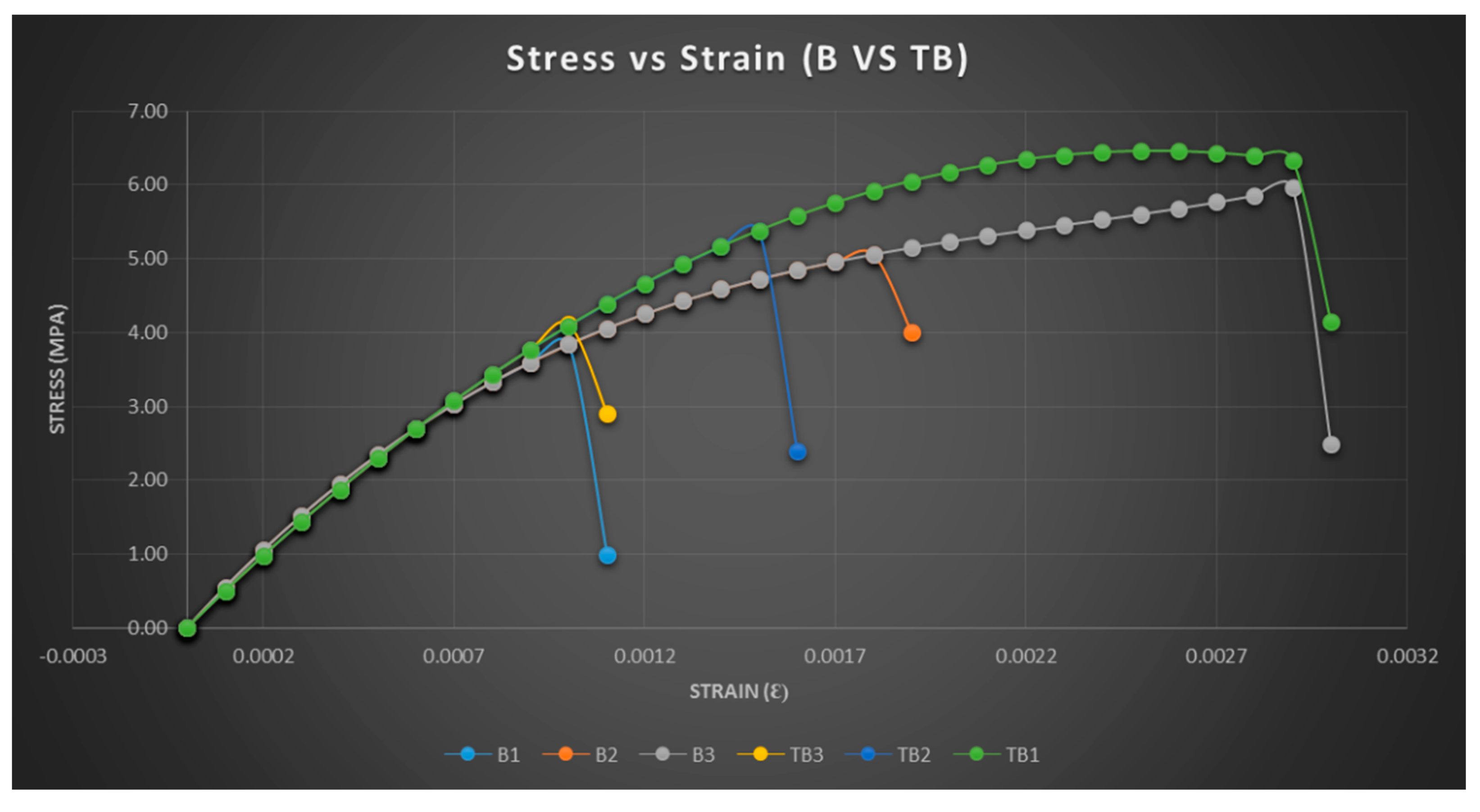
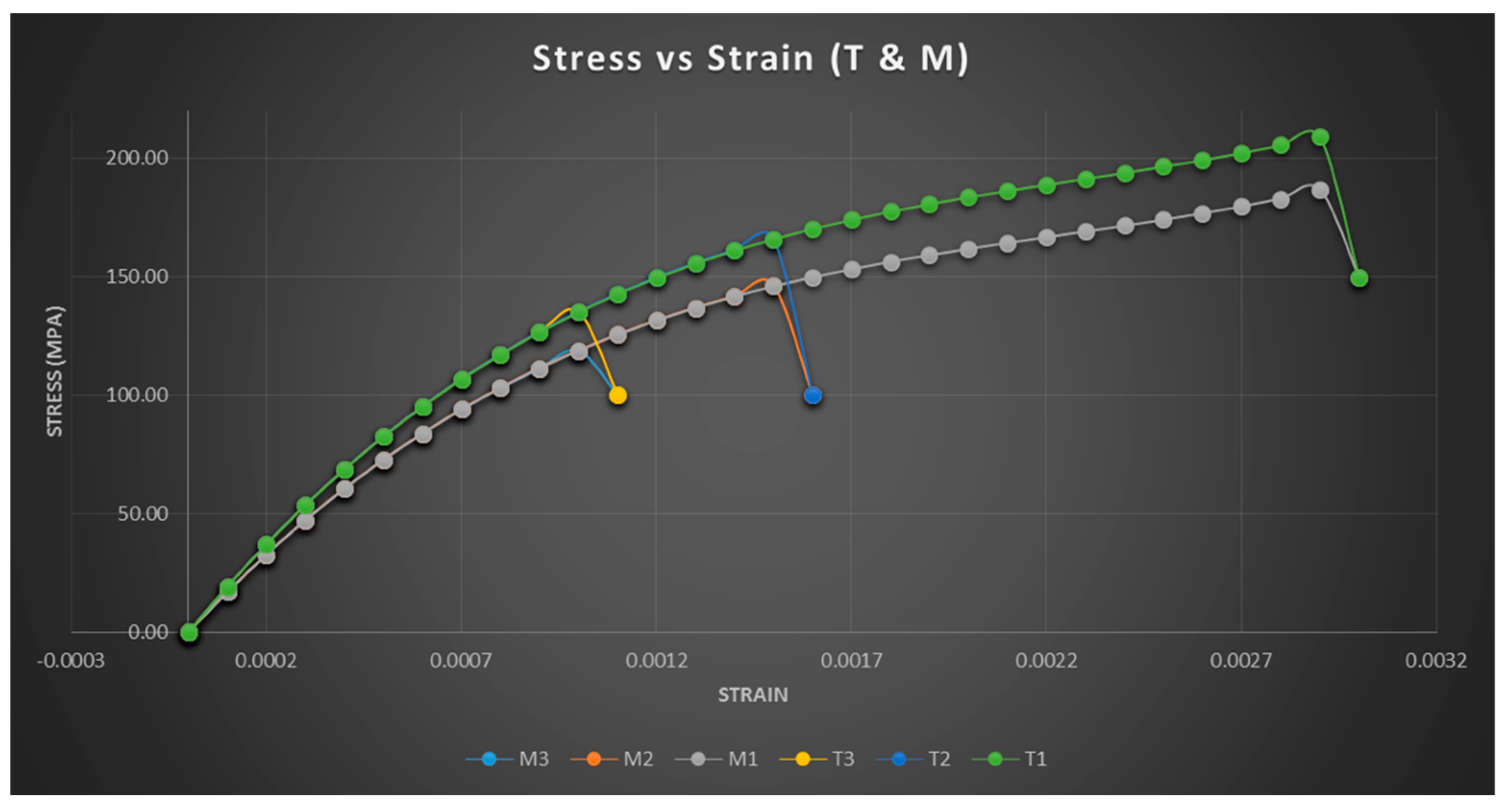

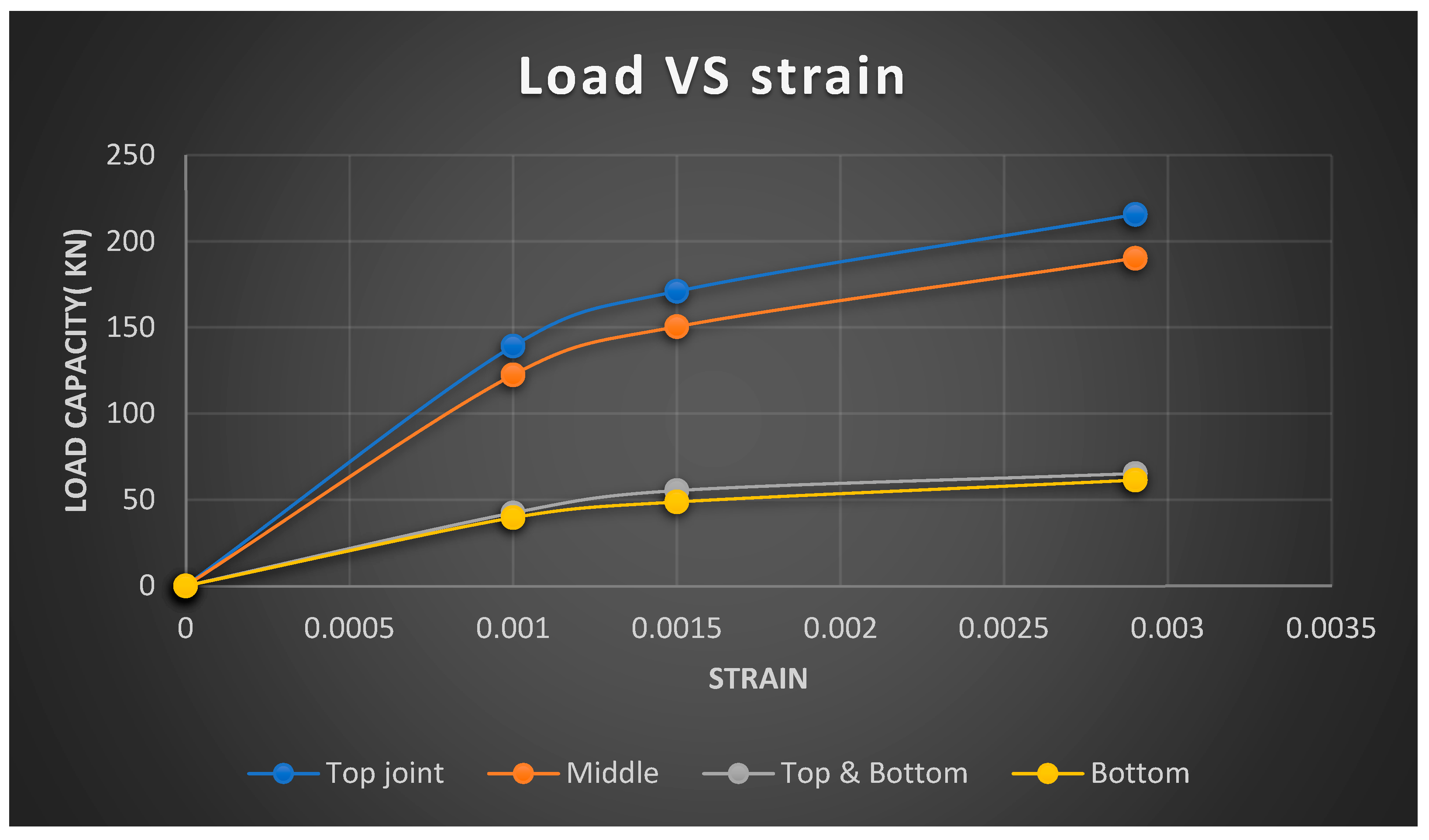
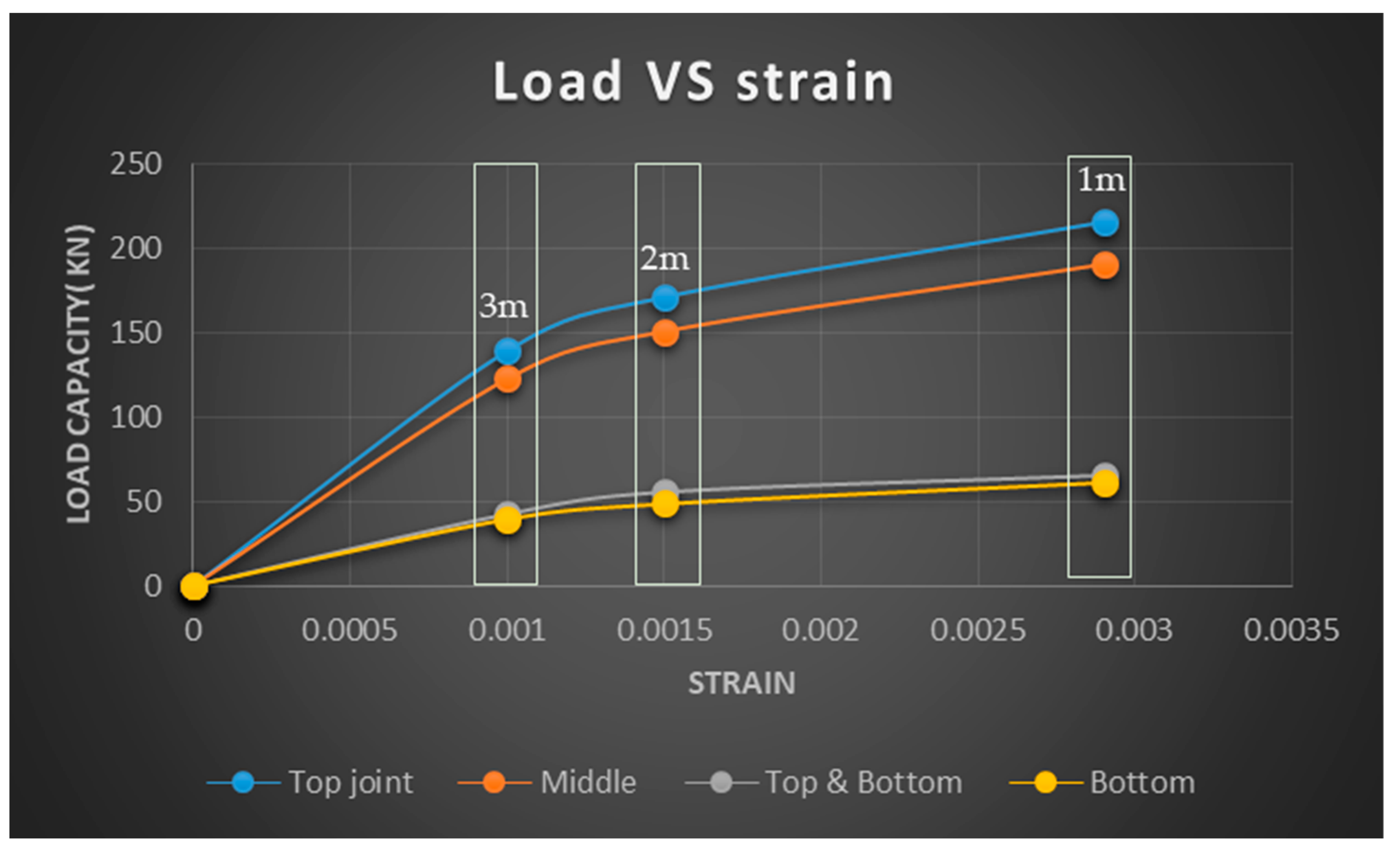
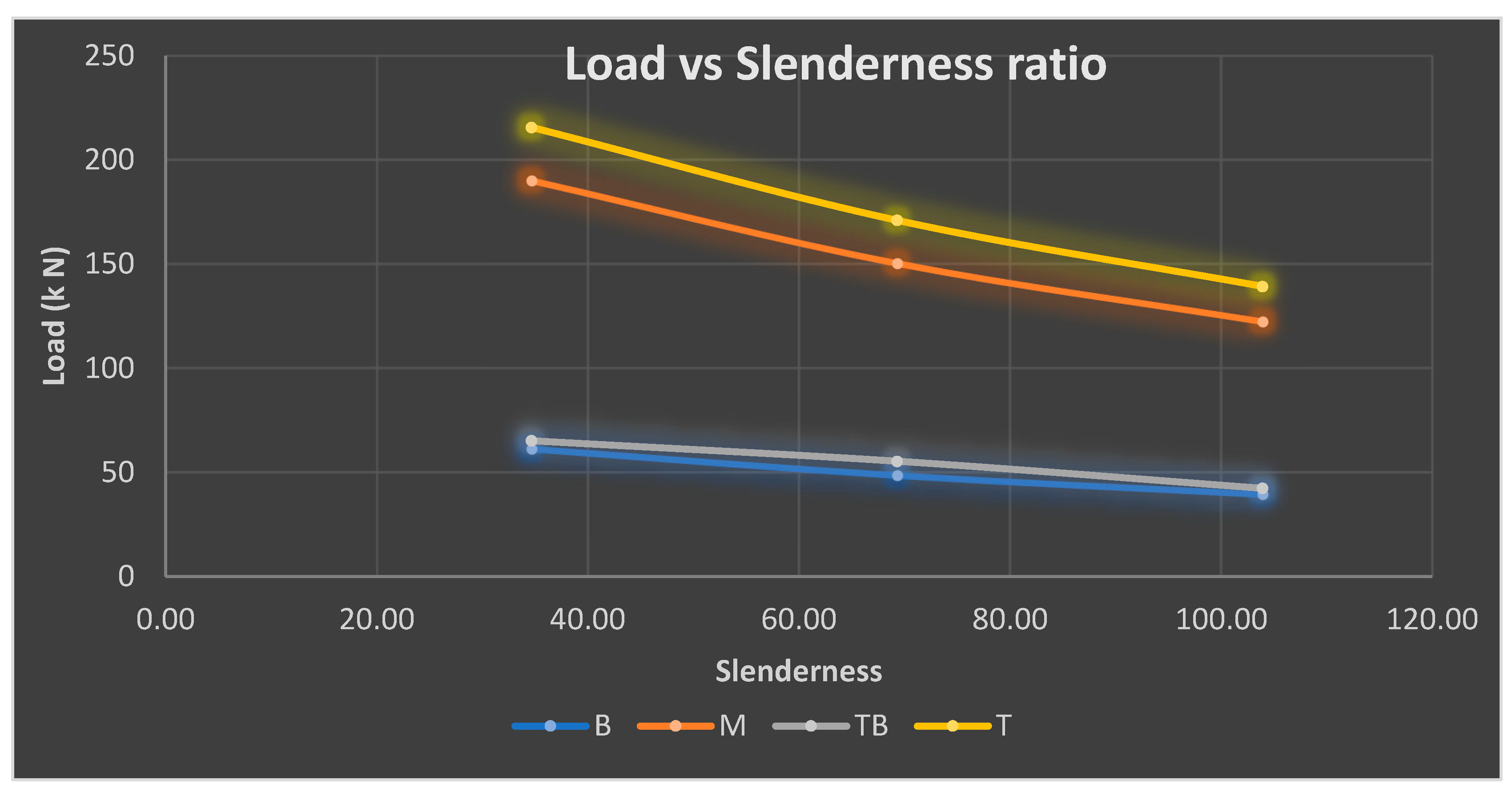

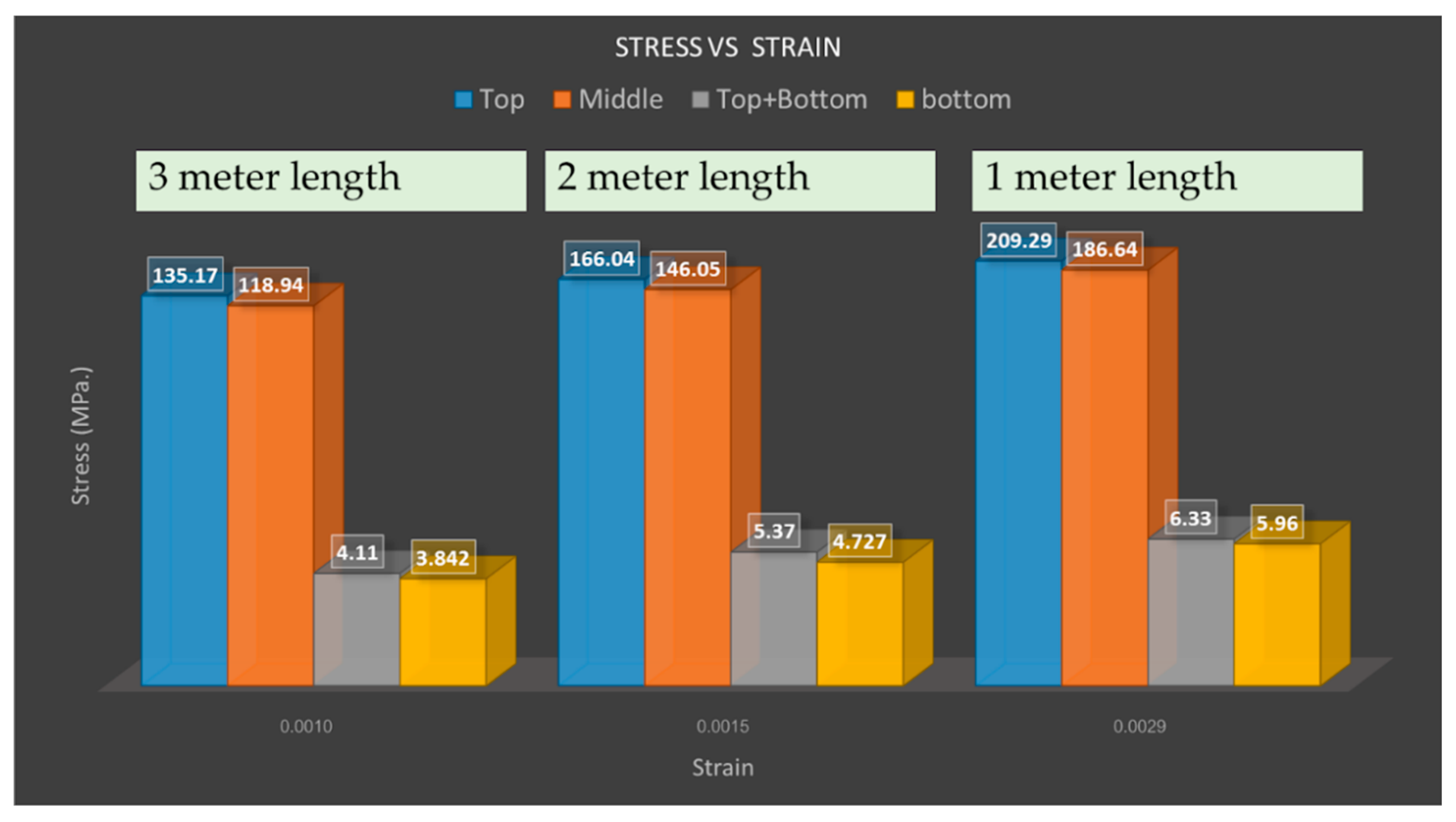
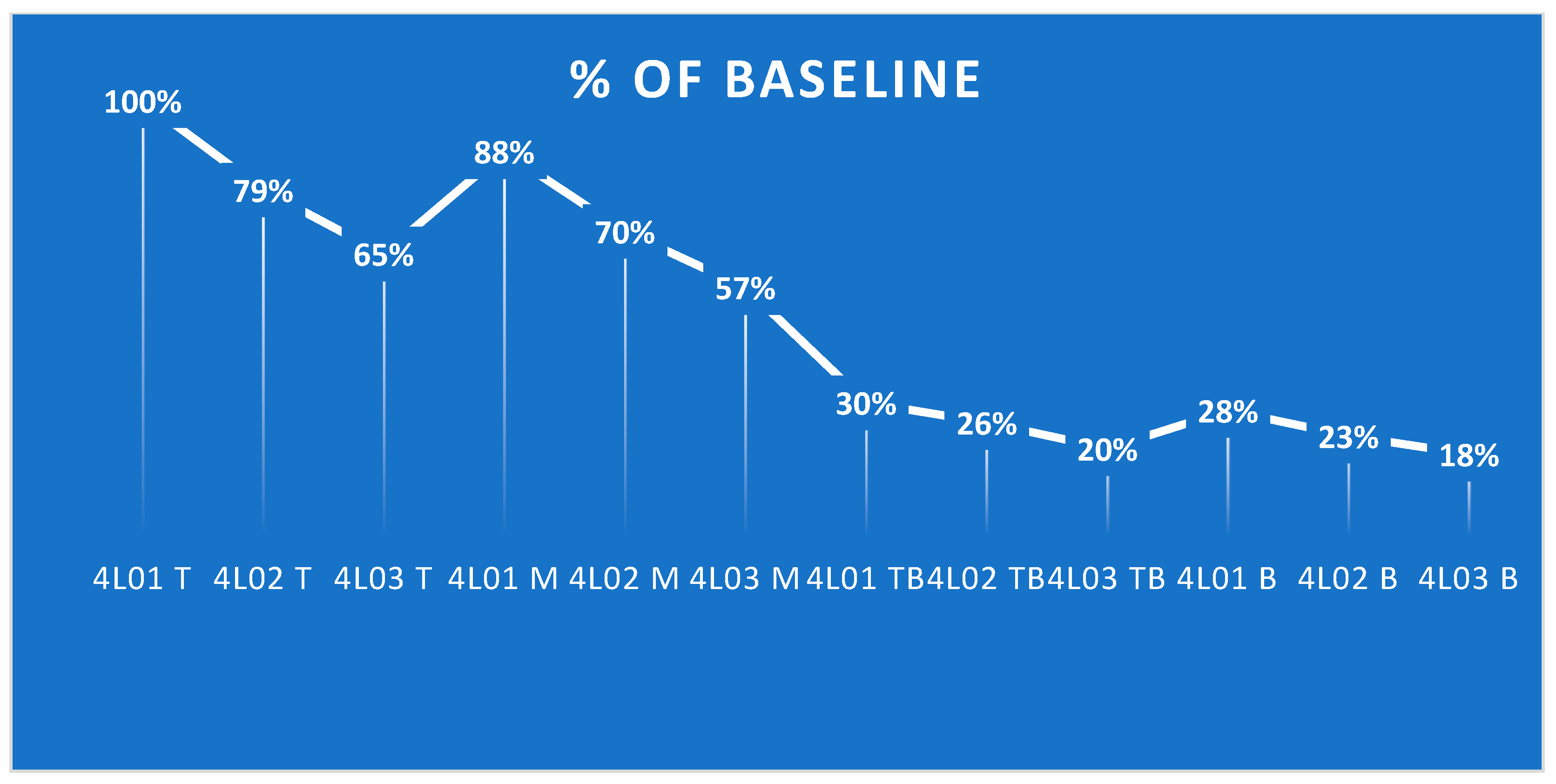
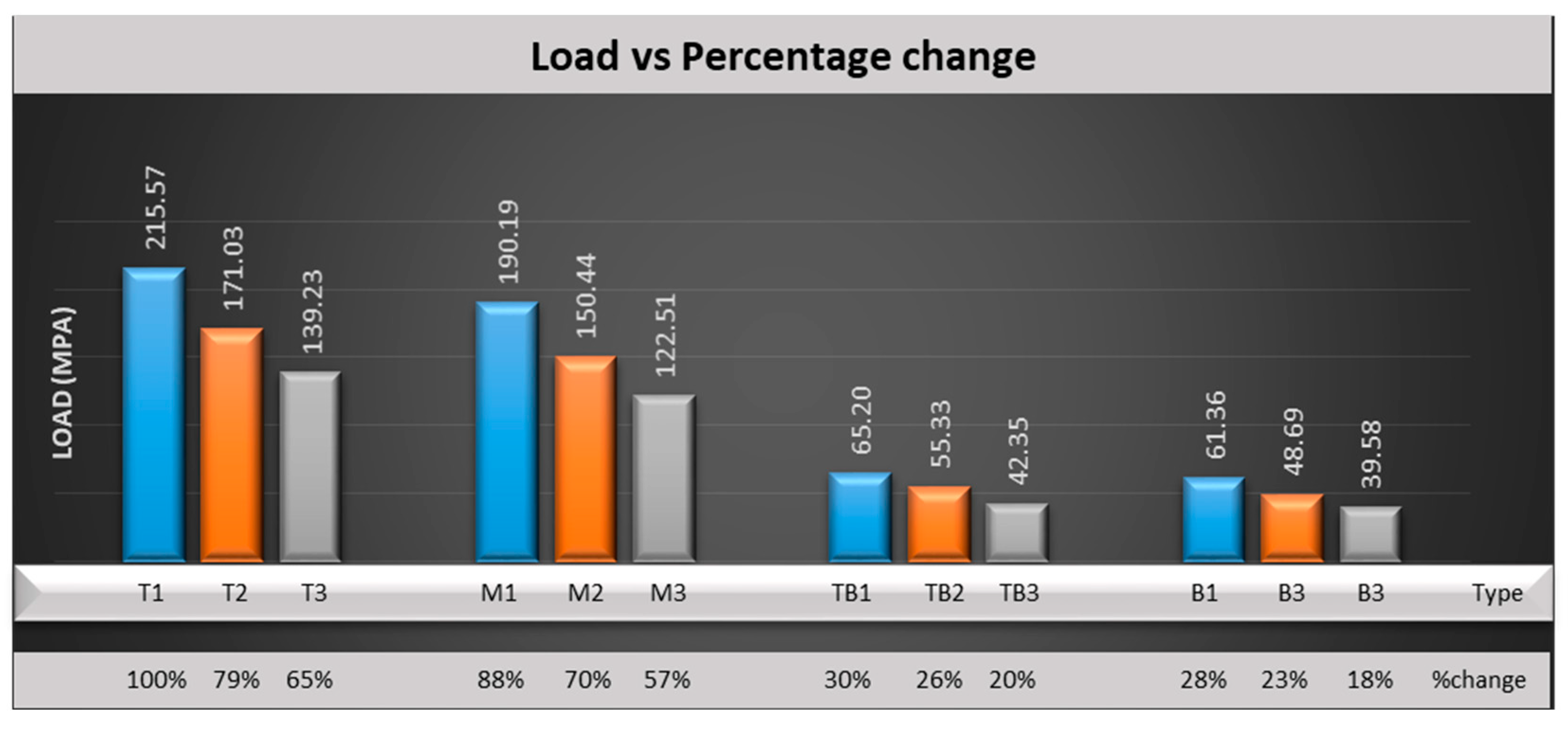

| Property | Maximum | Minimum | Average |
|---|---|---|---|
| Compressive strength parallel to grain fv (MPa) | 69.65 | 20.82 | 49.27 |
| Modulus of elasticity in compression EC (MPa) | 9518.59 | 5365.74 | 7721.04 |
| Type | Location of Joint | Code | Length (m) | Number |
|---|---|---|---|---|
| 4L01 B | bottom | B | 1 | 6 |
| 4L02 B | bottom | B | 2 | 6 |
| 4L03 B | bottom | B | 3 | 6 |
| 4L01 TB | Top and bottom | TB | 1 | 6 |
| 4L02 TB | Top and bottom | TB | 2 | 6 |
| 4L01 TB | Top and bottom | TB | 3 | 6 |
| 4L01 M | middle | M | 1 | 6 |
| 4L02 M | middle | M | 2 | 6 |
| 4L03 M | middle | M | 3 | 6 |
| 4L01 T | top | T | 1 | 6 |
| 4L02 T | top | T | 2 | 6 |
| 4L03 T | top | T | 3 | 6 |
| Specimens | Mode | Type of Failure |
|---|---|---|
| 4L01T | 1, 2 | Splitting, Adhesive failure (ADH) |
| 4L02T | 1, 2 | Splitting, Adhesive failure (ADH) |
| 4L03T | 1, 2 | Splitting, Adhesive failure (ADH) |
| 4L01M | 1, 2, 3 | Splitting, Adhesive failure (ADH), Buckling |
| 4L02M | 1, 2, 3 | Splitting, Adhesive failure (ADH), Buckling |
| 4L03M | 1, 2, 3 | Splitting, Adhesive failure (ADH), Buckling |
| 4L01TB | 4 | Splitting, Adhesive failure (ADH) |
| 4L02TB | 4 | Splitting, Adhesive failure (ADH) |
| 4L03TB | 4 | Splitting, Adhesive failure (ADH) |
| 4L01B | 1, 2 | Splitting, Adhesive failure (ADH) |
| 4L02B | 1, 2 | Splitting, Adhesive failure (ADH) |
| 4L03B | 1, 2 | Splitting, Adhesive failure (ADH) |
Publisher’s Note: MDPI stays neutral with regard to jurisdictional claims in published maps and institutional affiliations. |
© 2022 by the authors. Licensee MDPI, Basel, Switzerland. This article is an open access article distributed under the terms and conditions of the Creative Commons Attribution (CC BY) license (https://creativecommons.org/licenses/by/4.0/).
Share and Cite
Kitiyanun, K.; Kongsong, W.; Tuprakay, S.; Tuprakay, S.R.; Harnphanich, B.; Poowarakulchai, C.; Thammapornram, C. Mechanical Properties of Parallel TDG Bamboo Laminated Columns with Tough and Grove Joints. Designs 2022, 6, 107. https://doi.org/10.3390/designs6060107
Kitiyanun K, Kongsong W, Tuprakay S, Tuprakay SR, Harnphanich B, Poowarakulchai C, Thammapornram C. Mechanical Properties of Parallel TDG Bamboo Laminated Columns with Tough and Grove Joints. Designs. 2022; 6(6):107. https://doi.org/10.3390/designs6060107
Chicago/Turabian StyleKitiyanun, Krittapat, Waranon Kongsong, Seree Tuprakay, Sirawan Ruangchuay Tuprakay, Boontham Harnphanich, Chaiwat Poowarakulchai, and Chaleeporn Thammapornram. 2022. "Mechanical Properties of Parallel TDG Bamboo Laminated Columns with Tough and Grove Joints" Designs 6, no. 6: 107. https://doi.org/10.3390/designs6060107







